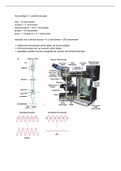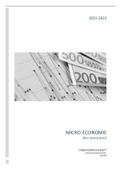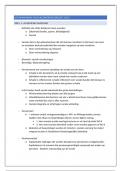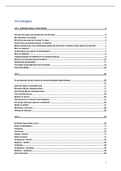Lecture 1. The Basics
Atoms and elements
Atoms contain a nucleus and a cloud of electrons, orbiting around that
nucleus. Atoms differ from one another by the number of positively charged
protons within the nucleus and an equal number of negatively charged
electrons. Within molecules, atoms are connected by covalent bonds. A
single covalent bond is created by sharing one pair of electrons. By sharing
electrons, atoms strive to get their outermost orbitals filled. The outermost
orbital can accommodate 8 electrons. In double bonds, four instead of two
electrons are shared. This has consequences for the physical properties of
the molecule, e.g. free rotation is impossible around double bonds, and the
molecule is flat (angle of 180°).
Carbon (C) Carbon constitutes the most abundant element in biology
(60% of our body's dry weight). Carbon has 4 electrons in its outer shell, so it has to
lose or acquire 4 electrons for outer shell saturation. The respective bonds show
tetrahedral orientation. If a carbon atom has bound 4 different substituents,
asymmetry dictates the existence of two stereo isomers, an L and a D form. Amino
acids in proteins are exclusively found in L-configuration. Only in the cell wall of
bacteria D-amino acids are present to support bacterial growth. Carbon has a unique
role in the cell because of its ability to form strong covalent bonds with other carbon
atoms to form chains, rings, or branches.
Hydrogen (H) Hydrogen is the smallest atom in Chemistry as well as Biology, and contains just one
electron and one proton.
Nitrogen (N) Nitrogen represents the second to most abundant element in biological dry body
mass (11%). With 5 electrons in its outer shell, nitrogen mostly accepts three
electrons to form 3 bonds.
Many C–N compounds are
building blocks, also called
functional groups or just
“functions”.
They constitute recurring themes
in biochemistry. Shown here is the amine (or amino) group, which can form amide
bonds with acidic groups.
Oxygen (O) Oxygen represents 9% of our body’s dry mass. With two electrons missing in its
outer shell, oxygen mostly accepts two electrons to form two bonds.
Many C–O compounds
are building blocks, also
called functional groups
or just “functions”. They
constitute recurring
themes in biochemistry in
the form of carboxylic
acids, carboxylate, esters,
amides, thioesters, acyl
phosphates, acyl chlorides, or acid anhydrides.
1
,Summary Protein Science, Danielle Band, 2702582
Forces and interactions
Electronegativity
Within a covalent bond, some atoms are more able to attract electrons
than others which depends on the electronegativity. Electronegativity
takes place in functional groups when the atoms are not the same. The
atoms in the first row of the periodic table have the highest
electronegativity, because they have fewer shells, and are thus not able to
shield the positive charge of the nucleus. When the atom gets bigger, and
has more shells, the atom attracts electrons less. Electronegativity can
invoke polarity, because there is an uneven charge distribution within
molecules. The magnitude of this effect is dependent on the differences in
electronegativity between the atoms actually participating in a chemical
bond. In extreme cases, differences in electronegativity can even allow the
generation of ions, which may still attract each other in ionic bonds.
Protonation, and deprotonation (pH)
When bound to atoms of higher
electronegativity, hydrogens can dissociate
and cause ion pairs. When the released
proton subsequently binds to water,
hydronium ions (H3O+) are formed. This is called protonation and
deprotonation. Amino groups show the opposite tendency, they can
accept protons and thereby become positively charged. This very
reaction happens as well in pure water itself.
pH = -log[𝐻3 𝑂+ ] [𝐻3 𝑂+] = 10−𝑝𝐻 M
The concentration of hydronium ions (in mol/l, M) is expressed as pH. For strong bases, or acids, almost
complete (de)protonation takes place. For weak acids and basis there is an equilibrium between
protonation, and deprotonation. To quantify the tendency to acquire or loose protons, the pKa value
indicates at which pH a compound is half protonated. The 𝐾𝑎 value is the equilibrium dissociation
constant of an acid. Of both formula’s below, logarithm formula is easier to handle because the pKa
value is the pH value at which 50% of the protons are released.
[𝐴− ][𝐻 + ]
𝑘𝑎 = 𝑝𝐾𝑎 = −𝑙𝑜𝑔10 𝐾𝑎
[𝐻𝐴]
2
,Summary Protein Science, Danielle Band, 2702582
Interactions between chemical groups (always in the exam)
Noncovalent Short range repulsions = Short range repulsion
interactions occurs when the atoms come in close proximity,
involving less than the sum of van der Waals radii (sum of
charges the radius of the atom), and the orbitals start to
overlap. For each atom, the van der Waals radii
may vary responding to environmental influence.
This highly increases the energy needed to interact
and eventually makes the interaction impossible.
Electrostatic forces – point
charges = Electrostatic forces are
the attractive or repulsive
interactions between objects
having electric charges. A point charge is a hypothetical charge located at a single
point in space. Proteins that have taken up an electron, have, in theory, a point
charge, but because the charge is normally spread out between multiple atoms, it
loses its name as a point charge.
𝑍𝐴 𝑍𝐵 𝑒 2
∆𝐸 =
𝜀𝑟𝐴𝐵
The energy difference for approaching two atoms, A and B, with charge Z from infinite
distance to distance r can be calculated using Coulomb’s law. In this formula is e the
charge of an electron and ɛ the dielectric constant. The value of ɛ depends on the
environment/medium. Strictly, Coulomb’s law holds true only for point charges. Since
ions in proteins are of finite size, the equation is valid only at distances significantly
greater than atomic dimensions. Salt bridges in proteins occur between ionizable side
chains. Due to processes like resonance and protonation, often components of
hydrogen bonding are involved.
Electrostatic forces – dipoles = Different electron attraction by atoms comprising a
group or side chain may induce an uneven distribution of electrons, this is called a
dipole.
𝜇𝐷 = 𝑍𝑑
The dipole moment 𝜇 quals the product of the
magnitude (size) of the separated excess charge Z
times the separation distance d. Dipole moments are
vectors with magnitude and direction. There are
three different dipoles:
• Permanent dipoles – This may exert attractive
or repulsive forces, dependent on spatial
arrangement. Permanent dipoles occur when
there is a significant difference in
electronegativity between one atom, and the
atom covalently attached. When two
permanent dipoles interact it creates a
dipole-dipole interaction. The partial positive
side of an molecule only attracts the partial negative site of another molecule,
3
, Summary Protein Science, Danielle Band, 2702582
and repulses its partial positive site. When the partial positive is closer to the
partial negative than to the partial positive, attraction takes place.
• Induced dipoles – Induced dipols take place when only one of the two
molecules has a permanent dipole, and is thus polar/charged, and the other
one is non-polar or neutral. The only attractive force originates from the
neigboring permanent dipole, and is thus always attractive.
• (London) Dispersion forces - London's dispersion forces can be defined as a
temporary attractive force due to the formation of temporary dipoles in a
nonpolar molecule. The other name for this force is van der Waals interaction
Van der Waals interactions = London or dispersion forces lead to van der Waals
interactions which are distance dependent. Since they occur amongst all kinds of
molecules, they are more abundant than other dipolar interactions.
Hydrogen bonds = Hydrogen bonds occur as two
electronegative atoms compete for the same hydrogen
atom. Hydrogen can be covalently attached to one atom, but still interact with
another one due to its small size and low electronegativity (high charge). Lengths and
strengths of hydrogen bonds depend on the electronegativities of the participating
atoms. Water is often (not in ice) involved in hydrogen bonding, but also many amino
acid side chains can potentially be involved in hydrogen bonding.
Hydrophobic The hydrophobic effect forces nonpolar solutes to interact with each other instead
effect of the solvent, excluding them from water. As a result, hydrophobic side chains are
forced into the protein’s interior. This effect comprises a major force ruling in
protein folding.
Basic thermodynamics/kinetics
The Gibbs free energy
ΔG = ΔH - TΔS
The Gibbs free energy
change combines the
changes of Enthalpy, and
Entropy. Enthalpy (ΔH)
reflects the difference of
noncovalent interactions,
and has to be < 0 to be
able to release heat. The
entropy (ΔS) is the
disorder of a system, and
is > 0 if t disorder increases. The second las of thermodynamics states that the disorder of the universe
always increases which means that: ∆𝑆𝑢𝑛𝑖𝑣𝑒𝑟𝑠𝑒 = ∆𝑆𝑠𝑦𝑠𝑡𝑒𝑚 + ∆𝑆𝑠𝑢𝑟𝑟𝑜𝑢𝑛𝑑𝑖𝑛𝑔𝑠 > 0.
Non-polar solutes form droplets (stick together)
to minimize the surface that comes in contact
with water. This causes a cage structure of water
molecules surrounding the non-polar solutes. The
inside of this cage had more structure than the
surrounding bulk media. This means that the
surrounding bulk media has more freedom than the non-polar solutes.
4






